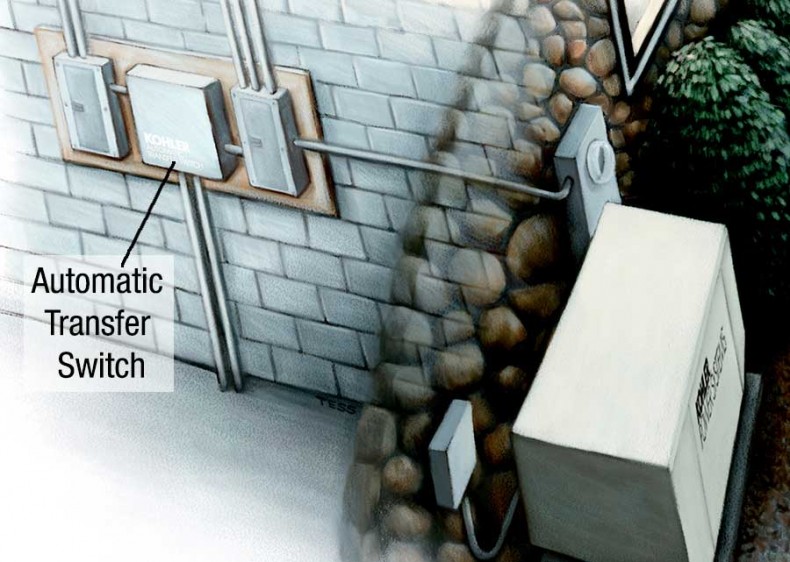Back-Up Power
A buyer's guide to residential standby generators
By Tom TateTo avoid dangerous back-feeding of electricity into utility systems, have a qualified, licensed electrician install a double-pole, double-throw transfer switch between the generator and utility power.
Let's face it: rough weather happens. When a major storm hits, power may be out for an extended period of time. Anyone who has experienced an extended power outage has likely mulled over the idea of buying a generator. But before you do, make sure you have all the facts.
The purchase and installation of a generator is an important and serious decision. Properly done, you gain peace of mind knowing your family can ride out any outage with some degree of comfort. But an incorrectly implemented generator can become deadly to you, your family, your neighbors and your electric cooperative's employees.
So, let's look at the decisions you'll need to make when it comes to purchasing a residential generator. First, do you want to back up your entire home or just portions? The biggest drawback to a permanently installed, whole-house generator is the cost. While the advantages are significant, it is a large expense for most folks to cover. The table illustrates several characteristics of each alternative.
The next decision is sizing the generator to your particular situation. Online tools abound, so if you like to research, just type "generator sizing guide" into your browser and off you go. Or, contact your cooperative to help you determine the size. All this being said, a nice portable generator size is at least 6,500 watts with a startup capacity of around 8,000 watts. When motor loads start — such as a water pump or refrigerator — they draw more power than they use when running. This "in rush" of power gets them spinning. Afterwards, their demand for electricity decreases.
The third consideration is how to integrate the generator with your home. Permanent models have dedicated switching devices that handle this chore, while portable models require you to remove them from storage, set them up, connect them and start them up. Here is where the danger mentioned above comes in to play. If you connect a portable electric generator to the main electrical supply coming into the house, the electrical generator could feed back into your electric cooperative's system and electrocute workers who are repairing the electrical lines. To avoid back-feeding of electricity into utility systems, have a qualified, licensed electrician install a double-pole, double-throw transfer switch (see illustration) between the generator and utility power in compliance with all state and local electrical codes. Be sure to closely follow connection instructions, and contact your cooperative if you have any questions regarding connecting your generator safely.
And never run a portable generator inside your house or garage. Keep it outside and not near a window to prevent carbon monoxide poising in the home.
Next, a word about quality. With generators, you definitely get what you pay for. Cheap models are just that. They may last a couple of years, but after that, parts can be impossible to get. Few things are worse than your generator failing to operate when the lights are out. Definitely go for engines with recognizable brand names. They may cost more, but it will certainly be worth it.
It's important to exercise your portable generator regularly. Don't worry, you don't need to walk your generator — it's not that type of exercise. Exercising means connecting load to it and turning it on to be sure it will run.
It's a good idea to let your electric cooperative know you have a generator. Your co-ops can provide safety and connection tips if needed, and it will enhance the line crew's safety.
Residential Generators what to know before you buy
| Installation Type | Price | Operation1 | Capacity | Length Of Operation3 |
|---|---|---|---|---|
| permanent | expensive | automatic | whole house | can be indefinite |
| portable | more affordable | manual | typically partial2 | depends on fuel tank size |
 1 Permanent generators start upon loss of grid power. They also exercise themselves automatically.
1 Permanent generators start upon loss of grid power. They also exercise themselves automatically.
2 Frequently powered: refrigerator, pumps (well, sump, septic), furnace, some lights, stove.
3 Permanent generators use propane or natural gas, portable use gasoline. Permanent models offer significantly longer operating times.
Image of portable generator provided by SafeElectricity.org
About the Author
Tom Tate writes on cooperative issues for the National Rural Electric Cooperative Association.-
Share this story:




Comments (1)
Lynn Powers |
November 30, 2015 |
reply